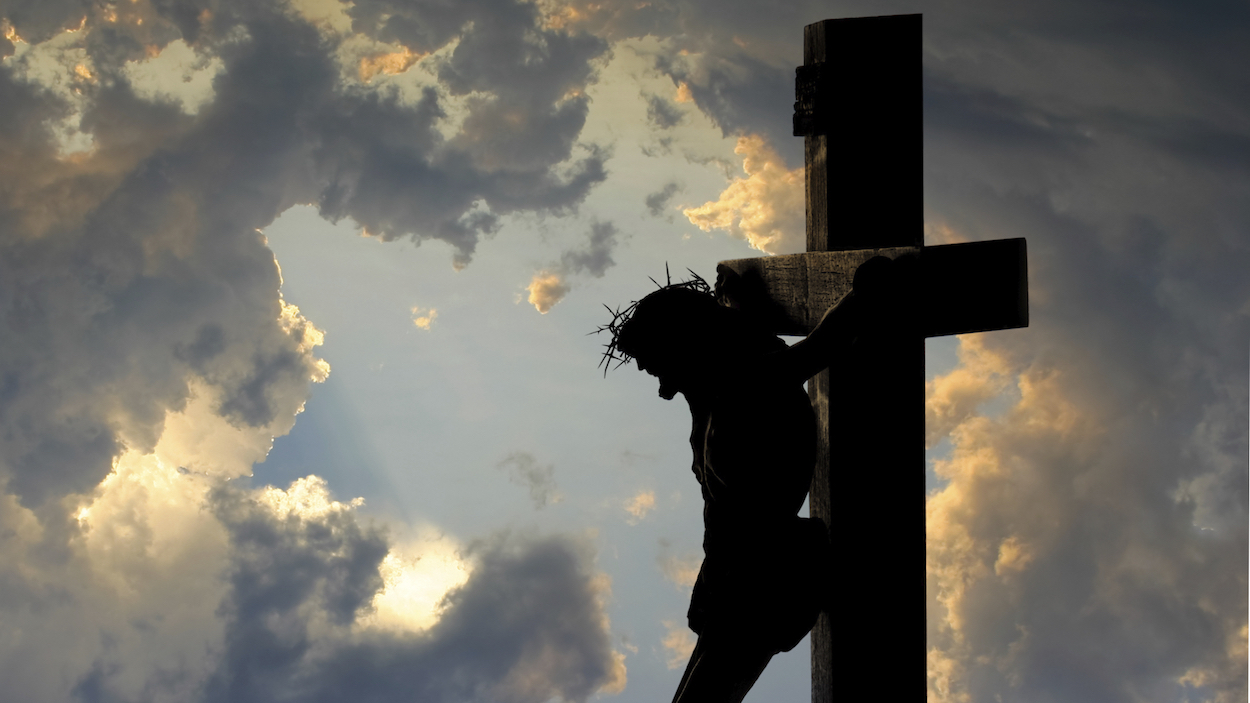For people educated in the Catholic faith, the death of Jesus on the Cross and His Resurrection rank among the most important teachings in Church history. As St. Paul proclaimed in I Corinthians: 15:15-17, For if the dead do not rise, neither has Christ risen; and if Christ has not risen, vain then is your faith because you are still in your sin. In a Biblical nutshell, here is the essence of Christ’s death and resurrection.
As for Jesus’ actual demise, does it matter how He died? Why could not Jesus have had 40 years to travel the world, spreading the Word and engaging all nations? After that, He could have naturally passed away after his allotted three score and ten. No, I think the manner of His death and maybe even more, the identity of His executioners were vitally important to the substance of the Church’s teaching. As I quipped at one of my Men’s Bible study meetings in St. Louis, it has been written, so Jesus could not have died by a drive-by-shooting or its first-century equivalent!
My quip had been inspired by a ridiculous cartoon on the death penalty in the St. Louis Review, the diocesan newspaper. The cartoon depicted Jesus hanging from His Cross. Its overt purpose was to condemn His execution because He had suffered from the death penalty, which according to a future Bishop of the Church was an intrinsic evil. Both the cartoonist and the paper’s editors demonstrated their overt ignorance of Church teachings, so great was their obsession for revoking what had been a standard teaching for most of my life, up to that point.
There seems to be some confusion as to just who was responsible for Jesus’ death on the Cross. I was reminded of an interview I conducted on WGNU radio many years ago, with author Dr. Richard Jenkins, a recovering Catholic. (A term coined by a caller many years ago, who had left the Church.) Jenkins was then the Chair of Penn State’s Department of Religious Studies.
As we neared the end of our hour, I added a question to my list, based on his last response about the Romans being responsible for Christ’s crucifixion. Since this statement was new to me, and it contradicted my understanding of Christ’s passion and death, my question to the professor was, Well if that was true, what was His crime? He never answered my question. I will never know if he had a good comeback or he was saved by the bell, because we ran out of time. I think I had been reminded of my understanding of the Bible chapters and verses on this. I could only picture images of Pilate washing his hands and saying, I find no guilt in this man.
Fast forward to an op-ed piece, by Bret Stephens, in the December 13, 2023 issue of the New York Times. I used to read Stephens in the Wall Street Journal. We were in agreement, about half of the time, but in his new position his neoconservative views have a distinct Woke flavoring that leaves a bad aftertaste.
I was surprised that this piece was not part of his regular appearance with Times colleague Gail Collins, who I surmise was raised Catholic because she attended Seton Hall High School and Marquette University. When I read Stephens, it is usually in their blog, which the newspaper publishes under the heading of The Conversation. From reading their congenial exchanges, she seems more the dominator with a hard-core liberal bent. By comparison, Stephens appears at times, politely defensive and never seems to be combative like the old donnybrooks between liberal Shana Alexander and conservative James Kilpatrick, which used to be a part of the Point/Counterpart debate segment of 60 minutes in the 1960s. They could sometimes be strident, with their passions spilling like knocked-over wine.
While this may sound a bit tasteless, to illustrate my point, I cannot help but think of a Saturday Night Live skit, which satirized the program’s intensity many years ago. With actor Dan Aykroyd playing Kilpatrick and Jane Curtin, Alexander, Aykroyd opens with the salvo, Jane you ignorant slut… I do not remember another word but I think I have made my point. Stephens and Collins exchanges were never in poor taste or vulgar, but they often savaged Republicans because ideologically speaking, they are on the same page.
This recent piece featured just Stephens. It was entitled Antisemitism: A Guide for the Perplexed. To maintain their usual format, he replaced Collins, with some sort of imaginative image, which I choose to call Straw Woman. The first word in his title is one of those trigger neologisms that prompts me to detour and ask for a definition of the term because it is often a conversation-stopper and immediately undermines any hope of a real honest discussion. I include some more recent examples, such as racism, homophobia, transphobia and some other Woke terms I have not internalized yet.
According to writer Richard Levy in Jewish Learning the term Antisemitism was coined in the late 19th century as a response to what was called the Jewish Question. The Question was precipitated by the remarkable economic, cultural and political assent…and their entry into mainstream European life. Jews were no longer seen as outsiders but as players in the economies of many different countries. A few generations later, the original question became a Nazi code word for the extermination of all European Jews.
In today’s heated political climate of Cancel Culture, I think this term and all similar words have shrouded themselves in an opprobrious pelt that has been deliberately thrown around to brand anyone with the temerity to criticize anything said or done by anyone with Jewish blood. Personally, I believe the term, Antisemitism, was designed for that purpose or if not it has certainly evolved into one. Even legitimate critics have to skate on thin ice.
The word that caught my eye in Stephens’ self-dialogue, was when he mentioned the word, Deicide, in answer to what was essentially his own statement. Like a skilled lawyer, Stephens, who I just learned was Jewish, would not ask himself any question, for which he already did not have a ready answer. The question he raised is based on his belief that antisemitism is essentially a conspiracy theory. When these two concepts are linked together, they create a two-fisted punch that will make any critic put down his pen.
The Straw Woman’s question was: Such as? Stephens responded: Deicide for one. The idea that the Jews got the Romans to kill Jesus. I beg to differ. My beliefs are mostly based on the Gospels of the Catholic Church, which have been in existence for nearly 2000 years. I guess if I were Stephens’ Straw Woman but with an educated and inquisitive brain, I would pose him the same question that professor Jenkins got.
To the Jewish leaders, the major crime Jesus’ committed was to claim He was the Jewish Messiah, who the Jews had been waiting for centuries. Unfortunately, Jesus was not the kind of Messiah the Jews longed for. They wanted someone to empower them so they could throw off the Roman yoke. But Jesus promised peace, love and salvation…not victory, power and wealth.
So the Jewish leaders, from the Sanhedrin, especially the Pharisees tried to get Jesus to alienate the Governor of Jerusalem, Pontius Pilate. But Jesus had answered all the tricky questions from the Pharisees, the best being where they tried to trap him with where his allegiances were. I say, Render unto Caesar the things that are Caesar’s and unto God the things that are God’s.
This was not a plum post for Pilate. It had the taint of Siberia for Russian officials. If Pilate allowed the Jews to get out of hand and if Jesus had followers who would take up arms and die for him, it would have serious repercussions for Pilate…even fatal if he were recalled to Rome. During his interrogation of Jesus, he tried to find out if this holy man was indeed a threat to Rome and more importantly his position in Jerusalem. Pilate asked him about the Kingdom he promised to his followers. Jesus succinctly said, My kingdom is not of this world. This answer caused the Governor to dismiss any viable threat from this preacher.
So I ask again, what was His crime? Had the Jews had the power they would have immediately killed Jesus. Since they did not possess such power, they had to impress upon Pilate the serious need for Jesus’ crucifixion and death. Only Pilate and his soldiers could free them from this blasphemer, who claimed to be the Son of God. But Pilate could not find any reason to execute Jesus. So he had him unnecessarily scourged within an inch of His life, crowned with thorns and humiliated in front of jeering throngs. The Jews screamed, Crucify Him! Crucify Him.
At this time of the year, there was a tradition to release a prisoner. Pilate offered the Jews a choice between, a murderer and thief, named Barabas and the tortured Jesus. Give us Barabbas, the Jews angrily shouted. Pilate proceeded to give us a metaphor for eternity. In an act of pure cowardice, he summoned for a bowl of water and a cloth. He washed his hands of Jesus’ fate and instructed his soldiers to execute a man without sin or blemish so as to appease the Jews.
I think that Stephens conspiracy is real. It reflects the essence of the Greatest Story Ever Told. The Old Testament is filled with prophecies that saw this coming. It was a fulfillment of the Old Testament and gave birth to the New Testament and the Catholic Church. While the Jews had rejected their Messiah and the chief rabbis and their elders did intimidate Pilate, still he was a Roman and had a great deal of power and could have refused the Jews demands. I believe his fears and insecurities necessarily forced his cooperation.
This relieves the Jews of full blame for Jesus’ death. But according to God’s Divine salvific plan, the Jews had to initiate it because He was of their blood and salvation history needed the cooperation of all mankind. In Acts 4:8-12, Peter says that Jesus is the rejected stone who turned into the cornerstone…a reference to Psalm 118:22. In this case the Romans were co-conspirators with the Jews and represented the rest of mankind. Since the death and Resurrection of Jesus, the relationship between the Jewish people and the Catholic Church has been as varied as it has been complex, so as to prohibit me from treating it fairly. Two issues stand out. There was something called the blood libel.
My understanding has always been that the Jewish role in Christ’s death affected only the people who were involved, not all the Jews, yet unborn. Many believe the blood libel descended from the Passion of Christ in the Gospel of Matthew 27:25, where the Jews appear to take the blame for Christ’s death in perpetuity when the people answered His blood be on us and our children.
Since then, I have learned that the blood libel also refers to ridiculous claims from the Medieval Days. In its April issue from last year, The Catholic World Reporter defined the blood libel as bogus stories about the Jews kidnapping Christian children so as to drain their blood in a blasphemous ritual, in order to use it for magic, medicine and matzoh-making. Several Medieval Church leaders condemned these silly claims.
I do not believe this interpretation. Jesus and his followers were Jewish so how could all Jews be included. Bigotry and guilt are not genetic. Nor are children responsible for the sins of their fathers. As a child who began his Catholic education in 1949, I had never heard these accusations one time. The blood libel is as silly a story as is the belief that Catholics were responsible for the Holocaust, as some Jewish historians have perpetuated in the 21st century.
Another issue that has increased tensions between us was the calumny perpetuated against Pope Pius XII for his alleged inaction and silence about the Holocaust during World War II. This slander was started by an East German playwright, Rolf Hochhuth, who dramatized these falsehoods in his play the Deputy (the Vicar) in 1963, years after Pius’ death. Later research revealed that Hochhuth was the dupe of the Russians plot to discredit the late pope. These charges were proven false with the release of the Venona Project and the Mitrokhin Files, which had been extracted from the Russian archives after the collapse of the Soviet Union in 1991.
Pope Pius XII was not especially vocal in publicly denouncing the Nazis slaughter of the Jews for fear of increasing the persecutions of Christians and those who had converted from Judaism, like St. Edith Stein, who became a Carmelite nun. She perished in Auschwitz in 1942 because her Dutch bishops had protested the German treatment of the Jews.
But Pius did not ignore their suffering. He used Church property to hide, house and feed hundreds of Jews. The pope and his staff were credited with saving over 800 Jewish lives during the war. The Chief Rabbi of Rome, Israel Anton Zoller, was baptized in 1945 and took the name of Eugenio Maria Zolli. While the Jews severely criticized and denounced him for his Catholic conversion, the fact that Pius’ birth name was Eugenio Pacelli tells me that the Pope’s admirable actions had something to do with his conversion. I do not know how much lingers from those days but I fear there will always be constant tensions between the Catholic Church and the Jewish people. During the many convocations for Vatican II, Jewish observers were and still are offended by many passages in the New Testament. The phrase in John’s Gospel and something we still read at Easter time, such as the phrase for fear of the Jews, is high on their list. I believe they would like us to either dispense with the New Testament or at least rewrite John’s Gospel. Will this rift ever be healed in the future? One can only hope and pray. Since millions of Jews and Catholics have effectively abandoned their religious traditions in favor of a more cultural identity, this issue may eventually become moot.








